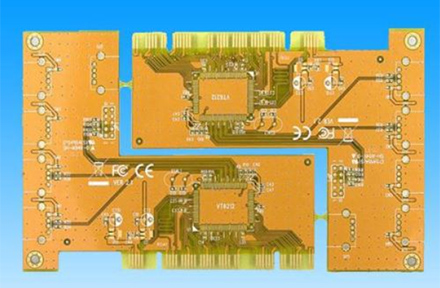Introduce common printed circuit board standards
- Categories:Company News
- Author:
- Origin:
- Time of issue:2021-03-08
- Views:
(Summary description)There are many standards in the circuit board industry, and the commonly used printed circuit board standards are as follows: 1) IPC-ESD-2020: A joint standard for the development of electrostatic discharge control procedures. Covers the presupposition, establishment, successful realization and protection necessary for electrostatic discharge control procedures. Based on the historical experience of certain military groups and economic activity groups, provide guidance for the sensitive period of electrostatic discharge disposal and best care.
Introduce common printed circuit board standards
(Summary description)There are many standards in the circuit board industry, and the commonly used printed circuit board standards are as follows:
1) IPC-ESD-2020: A joint standard for the development of electrostatic discharge control procedures. Covers the presupposition, establishment, successful realization and protection necessary for electrostatic discharge control procedures. Based on the historical experience of certain military groups and economic activity groups, provide guidance for the sensitive period of electrostatic discharge disposal and best care.
- Categories:Company News
- Author:
- Origin:
- Time of issue:2021-03-08
- Views:
There are many standards in the circuit board industry, and the commonly used printed circuit board standards are as follows:
1) IPC-ESD-2020: A joint standard for the development of electrostatic discharge control procedures. Covers the presupposition, establishment, successful realization and protection necessary for electrostatic discharge control procedures. Based on the historical experience of certain military groups and economic activity groups, provide guidance for the sensitive period of electrostatic discharge disposal and best care.
2) IPC-SA-61A: Semi-aqueous cleaning manual after welding. Covers various aspects of semi-aqueous cleaning, including chemical, produced remnants, facilities, processes, process control, and background and safety considerations.
3) IPC-AC-62A: Water cleaning manual after welding. Describe the production of remnants, the type and nature of aqueous cleaning agents, the process of aqueous cleaning, facilities and techniques, quality control, background control, staff safety, and the cost of calibration and calibration of cleanliness.
4) IPC-DRM-40E: Reference manual for through-hole welding evaluation desktop. In accordance with the requirements of the standard, detailed descriptions of components, hole walls, and welding surface coverage, etc., are also covered by computer-generated 3D graphics. Including tin filling, contact whiskers, tin wetting, vertical replenishment, solder pad covering, and a large number of missing solder joints.
5) IPC-TA-722: Welding Technology Evaluation Manual. Covering 45 articles on various aspects of soldering technology, the internal significance involves ordinary soldering, soldering materials, manual soldering, batch soldering, wave soldering, reflow soldering, vapor-phase soldering and infrared soldering .
6) IPC-7525: Model board preset guide. Provide guidance directions for the preset and production of solder paste and surface mount adhesive coating model boards. I also discussed model board presets using surface mount technology, and introduced elements with through-holes or flip-chip chips. The Kunhe technology of the parts covers register printing, double printing and staged model board presets.
7) IPC/EIAJ-STD-004: The specifications of flux need to cover Appendix I. It contains technical indicators and classifications of rosin, natural resin, etc., organic and inorganic fluxes classified according to the content and activation degree of the halide in the flux; also covers the use of flux, things including flux and exemption Low carryover flux used in the cleaning process.
8) IPC/EIAJ-STD-005: The specification of solder paste needs to cover Appendix I. Lists the characteristic signs and technical indicators of solder paste, and also covers testing methods and metal content standards, as well as viscosity, collapse, solder ball, viscosity and solder paste's wetting performance.
9) IPC/EIAJ-STD-006A: Specification requirements for electronic grade solder alloy, flux and non-flux solid solder. For electronic grade solder alloys, rod-shaped, ribbon-shaped, face-shaped flux and non-flux solder, for the application of electronic solder, and provide special terms for special electronic-grade solder with names, specifications and test methods.
10) IPC-Ca-821: General requirements for thermally conductive adhesives. Covers the need and test methods for thermally conductive electrical media to bond components to appropriate locations.
11) IPC-3406: Guidelines for Coating Adhesives on Conductive Surfaces. Provide guidance for the selection of conductive adhesives as solder alternatives in electronic manufacturing.
12) IPC-AJ-820: Assembly and welding booklet. It contains a description of assembly and soldering inspection technology, covering specific terms and definitions; printed circuit boards, component and pin types, solder joint materials, component installation, preset specification references and outlines ; Soldering technology and packaging; cleaning and laminating; quality assurance and testing.
13) IPC-7530: Temperature curve guide for batch soldering process (reflow soldering and wave soldering). In the acquisition of the temperature profile, it is deemed appropriate to use a variety of test hands and eyes, techniques and methods to provide guidance for establishing the best graphics.
14) IPC-TR-460A: Detailed registration form for wave soldering failure removal of printed circuit boards. Detailed registration form for a correction method recommended for faults that may be caused by wave soldering.
15) IPC/EIA/JEDECJ-STD-003A: Solderability test of printed circuit boards.
16) J-STD-013: Application of SGA and other high density technology. Establish specifications and interactions required for the printed circuit board packaging process, provide information for high-performance and high-pin-count integrated circuit packaging interconnections, covering preset principles information, material selection, wrench production and assembly technology, and test methods And reliable hope based on the background of the final application.
17) IPC-7095: SGA parts preset and assembly process replenishment. Provide a variety of useful operating information for many people who are using SGA components or thinking about problems to the field of array packaging; provide guidance for SGA inspection, measurement and maintenance and provide reliable information about the SGA field.
18) IPC-M-I08: Cleaning Guide Manual. Covers the latest version of the IPC cleaning guide, and helps them in the cleaning process and troubleshooting of products in the production of engineering models.
19) IPC-CH-65-A: Cleaning guide in printed circuit board assembly Question #e# 19) IPC-CH-65-A: Cleaning guide in printed circuit board assembly. It provides references for the cleaning methods that have been used and newly exposed in the electronics industry, covers the description and negotiation of various cleaning methods, and interprets the relationship between various materials, processes and contaminants in the production and assembly operations .
20) IPC-SC-60A: Manual for cleaning solvent after welding. The application of solvent cleaning technology in semi-automatic welding and manual welding is given, and the nature of the solvent, leftovers, process control and background issues are discussed.
21) IPC-9201: Handbook of Surface Insulation Resistance. It contains specific terms, theories, test procedures and test hands and eyes of the external insulation resistance (SIR), as well as temperature, humidity (TH) testing, failure standard patterns and failure elimination.
22) IPC-DRM-53: Introduction to the Reference Manual for Electronic Assembly Desktop. Diagrams and photos used to explain through-hole mounting and surface mounting assembly technology.
23) IPC-M-103: Surface mount assembly manual standard. The Ministry of Reinsurance includes all 21 IPC documents related to surface mounting.
24) IPC-M-I04: Printed circuit board assembly manual standard. It contains the 10 most widely used documents related to printed circuit board assembly.
25) IPC-CC-830B: Performance and identification of electronic insulating compounds for assembling printed circuit boards. The protective coating meets an industry standard for quality and qualification.
26) IPC-S-816: Surface mount technology process guide and detailed registration form. This troubleshooting guide lists all types of process problems encountered in surface mount assembly and their solutions, including bridging, missing soldering, and uneven placement of components.
27) IPC-CM-770D: Printed circuit board component installation guide. Provide effective guidance for the preparation of components in the printed circuit board assembly, and trace the relevant standards, influence and development status, covering assembly technology (covering manual and semi-automatic as well as surface mounting technology and flip chip Assembly technology) and thinking about subsequent welding, cleaning and film coating processes.
28) IPC-7129: Calculation of the number of failures per million opportunities (DPMO) and printed circuit board assembly production indicators. It provides a good method for calculating the benchmark index for calculating the number of failures per million opportunities.
29) IPC-9261: Estimated output of printed circuit board assemblies and failures per million opportunities during assembly implementation. It defines a reliable method for calculating the number of failures per million opportunities in the implementation of printed circuit board assembly, which is the weighing standard for evaluation at all stages of the assembly process.
30) IPC-D-279: Reliable surface mount technology printed circuit board assembly preset guide. A guide to the reliable production process of printed circuit boards with surface mount technology and hybrid technology, covering pre-defined ideas.
31) IPC-2546: Combination needs for the transfer of essentials in printed circuit board assembly. Describes the material movement system, such as transmission and conflict mitigation device, manual placement, semi-automatic screen printing, semi-automatic adhesive distribution, semi-automatic surface mounting placement, semi-automatic plated through-hole placement, forced convection, infrared reflow oven and wave burning weld.
32) IPC-PE-740A: Elimination of faults in the production and assembly of printed circuit boards. Covers example recording and proofreading activities of cases where problems were revealed during the presetting, production, assembly and testing of printed circuit products.
33) IPC-6010: Printed circuit board quality standard and performance specification series manual. Covers the quality standards and performance specifications established by the American Printed Circuit Board Association for all printed circuit boards.
34) IPC-6018A: Inspection and testing of microwave circuit boards. Covers the performance and qualification requirements of high-frequency (microwave) printed circuit boards.
35) IPC-D-317A: Use high-speed technology electronic packaging pre-set guidelines as deemed appropriate. Provide guidance for the preset of high-speed circuits, covering mechanical and electrical considerations and performance testing.
Scan the QR code to read on your phone
-
Basic knowledge of FPC circuit board
With the continuous increase in the yield ratio of flexible PCBs and the application and promotion of rigid-flex PCBs, it is now more common to add soft, rigid or rigid-flex when talking about PCBs, and say that it is a few-layer FPC. Generally, an FPC made of a soft insulating substrate is called a soft FPC or a flexible FPC, and a rigid-flex composite PCB is called a rigid-flex PCB. It meets the needs of today's electronic products for high density, high reliability, small scale, and lightweight progress. It also satisfies the strict economic requirements and the needs of market and technology competition. - Fpc flexible circuit board test method and standard 03-08
- Interpretation of four-layer PCB circuit board stack design scheme 03-08
- What are the common rules for PCB wiring? 03-08
- PCB assembly quality and reliability control of electroless nickel-palladium-gold plating 03-08
Service Hotline:
Email:lhdpcb@vip.163.com
Address:No. 26, Meiyuan 3rd Road, Intercontinental Industrial Park, Luoyang Town, Boluo County, Huizhou

Copyright ©Huizhou Linghangda Technology Co., Ltd. All Rights Reserved 粤ICP备18145577号
Power by: www.300.cn




 0752-6260118
0752-6260118 

 QQ
QQ 